(news & commentary)
So what to make of Nikon's new DSLR, the Nikon Df?
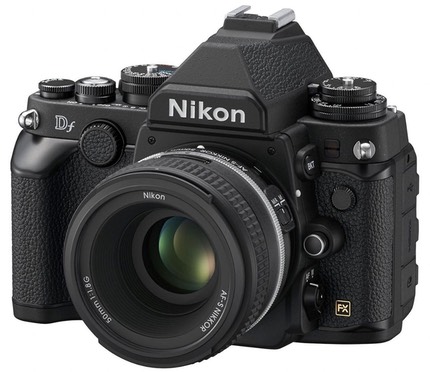
Let me warn you about one thing before we wade into the details: you're going to have an emotional response to the camera, not a rational one. The over-60 crowd will feel like they've come home again (at least on first sight), while the under-30 crowd is going to shake their head and wonder where the future of photography just went. The price will provoke a reaction from still others. All this is going to cause a great deal of emotional response in the emails, forum postings, and conversations that come now that the camera is fully known.
First, the specifics:
- 16mp FX sensor (ala D4)
- D610 digital guts (metering sensor, AF sensor, EXPEED3, 5.5fps)
- one SD card slot
- EN-EL14a battery
- D610-sized body (slightly slimmer due to less grip), but retro styled much like the old Nikon FA film SLR, and complete with dials for mode, shutter speed, ISO, and exposure compensation, a lever for frame advance (sic ;~), and a threaded cable release on the shutter release.
- No video support (but Live View is still available)
- US$2750 body only, US$3000 with new 50mm f/1.8G lens
The design of the body looks much like the old Nikon FA, and all the surprises boil down to the design, basically. The camera can mount and use even non-AI Nikkors, yet it comes with a new version of the 50mm f/1.8G to match the design style, replete with a nonfunctional silver ring. Does Nikon understand the word ironic?
When I heard that Nikon was moving forward with this design (prototype Q1020), I had to scratch my head. There's little doubt in my mind that many aspects of the Df will resonate with the Nikon faithful, but this new camera introduces a number of problems for Nikon when people actually think a little more about it. And that price just puts an exclamation point on it for some.
Had Nikon introduced this camera at Photokina 2012 instead of the D600, they would have probably had lines out the door for it. Why? Because people who owned the D700 didn't think that the D800 was the update for them. They wanted the D4 sensor in the D800 body, basically. A Df in 2012 would have given them much of what they wanted, plus it would extend back even further into legacy lenses that are directly supported. Sure, no 8 fps and no vertical grip, but those weren't the primary things that the D700 crowd wanted an update for. Meanwhile, the retro vogue was still leading edge in 2012, having really only been reignited by Fujifilm with a future camera at Photokina 2010 that appeared in 2011. Now retro is just de rigeur for a lot of companies. Fujifilm is all retro at this point. Even Sony is moving away from their minimalist NEX designs towards something more conventional and traditional.
But the DF introduces a whole host of questions if you really think about it. Why aren't all high-end Nikon bodies designed like this, for instance? If the past is so important and this camera sells in the quantities Nikon is hyping it for, then isn't that an indictment of the more modernistic designs they've been iterating for over a decade, designs that have more than 50 controls on the body and are all-in with the digital age?
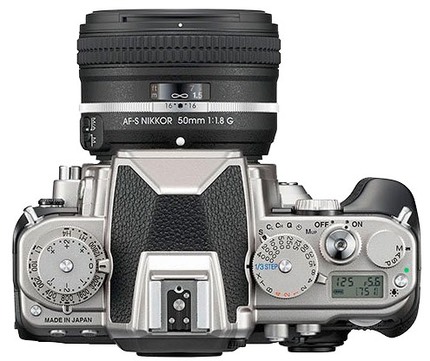
Moreover, retro seems confined to the top of the camera ;~). Look at it from above, and you think you're looking at a film camera without a rewind lever. Look at it from the back, and it looks like a Nikon DSLR, with all the requisite buttons and controls necessary for the digital age, and the big LCD under the eyepiece. From the front, it's a bit of a hybrid look, with the prism and the lack of much hand grip saying "film retro" while a closer examination shows programmable buttons and another control dial. Horrendously, the old screw cap on the PC sync socket we used to lose all the time makes a return. There's a bit more form here than function, I'm afraid.
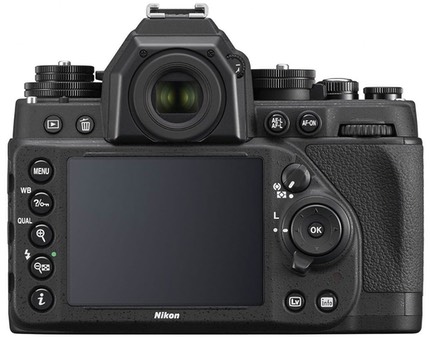
I've written before that the Japanese companies were making a simple mistake in trying to reinvent UI that wasn't broken. There really were four things you controlled in film: shutter speed, aperture, exposure compensation, and ISO (and that last one only each time you loaded a roll of film). Four dials, basically. To digital we need to add white balance. We can stretch that UI to add frame advance methods (single, continuous, self timer, mirror up) and autofocus methods, I suppose. But realistically, the number of things that most people are controlling for every shot is minimal. The DF is a refreshing step back towards that premise in that sense, but the current Nikon DSLRs aren't exactly problematic in these aspects as far as I'm concerned (location of some buttons can be a problem for some, though; but the dial locations are going to be problematic for some, too, as exposure compensation isn't on the top right where you'd expect it on the Df).
Unfortunately, the Df isn't all-in on the retro thing. Sure, you've got a shutter speed dial, but it is full stops only unless you move to a more automated setting (1/3 Step) that requires another control. When you're using a lens that has aperture rings, sure, you can basically do the match-needle metering thing. But the camera has all those modern era things, too, right down to an AF ON button. So realistically, what we have here is a 16mp D610 that's been styled differently, and has a bit more metal in its bones. Nikon called the combination "Pure Photography" in its elaborate teaser campaign for the camera, but I also noticed that they didn't provide any reason a Df was necessary. I could have wandered around the same bleak environs with a prime lens on my D3200 in manual exposure mode and had the same "pure" experience, I think. And I already wander around all day with my D800 without worrying about battery (on my recent Botswana workshop trip, I shot for days on a single charge), so the 1400 shots in CIPA testing of the Df is nice, but not something that should get you too excited.
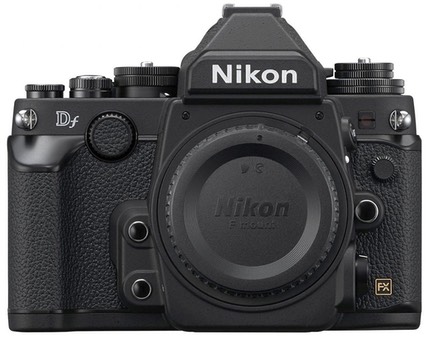
Which brings us to I think the fundamental problem with Nikon's entire FX lineup: what do they really want us to buy? In FX we now have:
- D610 at US$2000 (24mp, 6 fps)
- Df at US$2750 (16mp, 5.5 fps)
- D800 at US$3000 (36mp, 5 fps)
- D4 at US$6000 (16mp, 10 fps)
- D3x still lingering at US$7000 (24mp, 5fps)
Which camera does Nikon really want you to buy? Well, the D4 if you need fps and D800 if you need pixels, that much seems obvious. Yet the Df, D610, and D800 aren't all that different in function once you get past the pixel count and the nuance features and some styling/control differences.
Thus, this is style Nikon wants you to buy into. Remember what I wrote about colored cameras when they first started showing up: when camera makers start making differentials by purely style issues, that means they've hit a wall in terms of technology, performance, innovation, and features. Generally, differently styled products that aren't functionally removed from the conventionally styled ones get a brief burst of attention and sales, but unless those styled products actually function better for the task at hand, they usually quickly relegate to fashion statements.
Yes, I know. Some of you are positively salivating over the return of the shutter speed dial. But note that Nikon had to put a small LCD behind it for a reason: if you're not in an exposure mode where you're setting shutter speeds directly (shutter priority or manual), you still need to know what shutter speed you're using ;~). Here's my problem with retro designs that are bolted on: to see and assess the "state" of the camera you have to look in a lot of places: shutter speed dial, exposure compensation dial, ISO dial, mode dial, and the top LCD. The good news is that all of those things are on the top of the camera. The bad news is that they're in five places. How that's an improvement on me looking through the viewfinder and seeing all that, or looking at the top LCD and seeing all that together?
So what retro design tends to be is a pure nostalgia play. A big part of the DSLR user base is older, and it learned photography on film SLRs that had dials. Suddenly we old-timers get dials back and we go all weak-artificial-kneed and start drooling, apparently. If that's you, then don't buy a D610, buy a Df. It's not going to be a less complicated camera than the D610, though, and I'll bet that people buy my book on the Df to try to figure out all the nuances ;~). (Okay, the Df is less complicated in one way: all the video stuff is gone, so there are less connectors, a few less buttons, and some menu items aren't there to clutter things up. But it's still complicated.)
Let's look at things a different way. There are two different types of buyers: upgraders versus new buyers/holdouts.
The upgraders the Df appeals to most are those still holding film bodies and older lenses and are not into digital yet (or bought into it but don't like it), which really makes them new buyers/holdouts. As I noted, the D700 folk might see the Df as a sidegrade of sorts, though technically the D800 is the camera to which they should upgrade (yes, I know they lose some frame rate, but that's really all they lose, in my view; they gain a lot).
So how many new buyers or digital holdouts will the Df attract? Probably a lot until they notice the price and consider what the camera really is. Then the list of takers will be pared down some, I think. Still, there are enough Nikon old-timers around that will respond to the return of dials that this camera should sell enough to justify its existence.
What we have here is a parts bin reshuffle with a styling change. Take the D4 sensor, the D610 electronics, some older lens indexing parts, the D3200 battery, take the old FA or F3 blueprints out and adjust them slightly, do a mash up and you've got a Df. Is this the "clearly differentiated in terms of technologies and marketing" that the last Nikon annual report trumpets or the "truly innovative functions and performance" that Kimura-san's recent comments suggest is in Nikon's future? I think not. Like the D610, D5300, and AW1, the Df seems to me like a time-buying variation on current gear while Nikon rethinks what a camera really needs to be.
The problem I see is that Nikon made a big deal out of this launch, with a highly visible teaser campaign leading up to it that almost went viral. But now all Nikon users are scratching their heads like me: what is Nikon trying to tell us? Four very different FX bodies. A missing DX body. One large sensor compact. Underwater mirrorless. What camera do they really want us to buy? The releases since the D4 and D800 in early 2012 seem to be somewhat random in nature, and the clear DX/FX lines they gave us in 2007 are now all muddied up.
That said, you have to admit that most of Nikon's faithful enthusiasts are Baby Boomers who grew up with film SLRs. The re-appearance of the shutter speed dial and the old-style body design (as much as possible) seems to have whipped a lot of them into a frenzy. "That looks more like the camera I remember" seems to be enough to propel their interest, regardless of the specs. Indeed, I find many of the comments generated by the teaser campaign are very high on the retro bits, but quickly find ways to dismiss or ignore some of the other aspects of the camera ("I really don't need 24mp or more; it'll save me drive space," "I never liked the command dials interface," "I never use video, anyway," and so on).
The frenzy got so high at one point that there were multiple "oh my gawd, I just had an orgasm" remarks in various places on the net. Apparently these were folks who just took a little blue pill just prior to seeing the first photos of the new camera.
So I suspect the camera will be an early sell-out just based upon the visceral reactions I'm hearing. At least for those that don't think the price is an issue. The problem with a tease campaign, of course, is that there are three possible outcomes: (1) the hype fails to live up to the reality; (2) the hype is about equal to the reality; or (3) the hype didn't even come close to describing just how good the reality really is as the product far exceeds expectations.
It's rare that companies pull off #3. I don't believe Nikon has with the Df. Which leaves us to contemplate whether it's a #1 or #2. I'll point out that the teasers actually didn't tell us much. Basically: it's a camera, it's FX, it's retro styled, there's a new 50mm lens, the actor never seems to have any expression or reaction to it, he's just found standing in empty spaces contemplating what to do ;~). So technically Nikon isn't really responsible for all the speculative "it's a hybrid camera," "it's a mirrorless camera," "it's got a new focus system," "it's Nikon's answer to the Sony A7," "it has [fill in the blah]" hype that went flying around the Internet for the last 10 days. To a large degree, all the speculation made the pending camera seem like it might be more than it actually turned out to be.
That, too, is something that is tough about teaser campaigns. Coming so close on the heels of the Sony A7 announcement, a lot of folk took the teaser to levels of absurdity and predicted Nikon's first mirrorless FX camera (which would take non-AI lenses ;~). All those folks are going to think the campaign pulled a #1 (failed to live up to reality), though it's their own speculation that they should be truly disappointed at. The price doesn't help, either, as it's way above Sony's recent full frame entries, so Nikon won't be seen as matching Sony's pricing.
It's going to be interesting to watch the Web reaction to the Df. There are plenty of interesting things about the camera. The 16mp sensor, for instance, suggests that this might be a darned nice street shooting DSLR, for example. But all the dials? To me they're the least intriguing parts of this new camera. All they mean is returning to a slower approach to shooting I abandoned a long time ago. I kept my F6 film camera for a reason, for example, not my F100 or FM2n. Moreover, since I tend to shoot in aperture-priority mode at a fixed ISO, I won't be using three of the dials most of the time. Instead, I'll have to get used to changing exposure compensation on the left instead of the right top of the camera.
And then there's Auto ISO. We just got Nikon to make this function accessible (On/Off) via button+front dial. Now we don't have an ISO button any more, let alone an Auto function on the new dial.
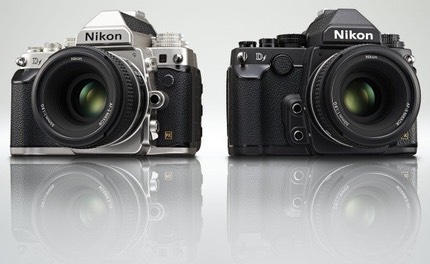
Random notes:
- The camera is available in all-black or black body with silver top and trim (see image, above).
- While the Df has the screw in eyepiece ala the pro bodies, it doesn't have a viewfinder shutter lever to close it. You get the cheap plastic snap on part instead.
- The card slot is in the battery compartment, ala compact cameras.
- The camera is made in the Sendai factory in Japan.
- All the dials have interlocks so that they don't move unintentionally. The mode dial must be lifted to turn it.
- Dials like this are nice during daylight hours. But at night? You'll be pressing the Info button or looking at the viewfinder display, I think. You might even press the button to light the top LCD ;~).
- Note the accessory problem for the upgrading Nikoneer: SD cards only, different battery, no built-in flash so you'll need something if you do fill, no 10-pin connector but the consumer MC-DC2 type connector, uses the D3/D4 eyepiece, etc. This means that you need a mishmash of accessories that might not match up to your current Nikon DSLR if you own one.
- Custom modes U1/U2 are gone. So are Scene exposure modes. I'm not 100% sure about shooting with Effects, but I think that's gone too. This is good news/bad news. The simplification of the mode dial does reflect the retro style well, but losing the U1/U2 modes means that you can't have the camera quickly pre-set for two different types of shooting (three, actually, if your U1/U2 are different than your normal exposure mode settings). On the other hand, you can set the camera without it being turned on (at least exposure compensation, shutter speed, mode, and ISO), which some will see as a gain. Personally, I think we lost something here. Indeed, PASM modes seem to be a bit in contradiction with the all-dial style. We had this fight back when "program," "aperture-priority," and "shutter-priority" first came about. The answer was an "A" mark on the dials. This is exactly what Fujifilm did in their retro design, and I believe it to be preferable to what Nikon did ("program" is then "A" on both shutter speed and aperture dials). Of course, Nikon has so many lenses now that don't have aperture dials, they got caught in a bad place with this.
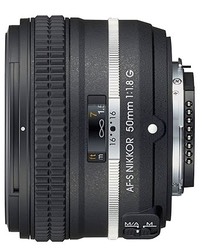
All of which brings us to the new lens. Why? Nikon just introduced a 58mm f/1.4G and now we get a 50mm f/1.8G revision. What for? Apparently so that it has a silver band to mimic the look of older Nikkors. We do get a not overly useful DOF scale back (markings for f/16 only, but infinity is nebulous as it always is on recent Nikkors). Does Nikon really think that people buying this camera don't already have a 50mm lens? Let's see, in its current lineup Nikon now has 45mm, 50mm, 50mm, 50mm, 50mm, 50mm, 50mm, 50mm, 55mm, 58mm, 60mm, and 60mm lenses you can use with the Df. 12 different "normal" lenses. A whole heck of "normal" is going on in Japan, apparently.
One final comment: this is your father's Oldsmobile. (If you're under 40, you might not catch that reference; it has to do with the way GM tried to bring themselves into the future via body changes and advertising.) What I worry about is that it is only the father that's asking for it. The Df very well may be the first camera marketed and sold to the AARP crowd. First women, then surfers, now retirees. What's the next niche target mashup camera going to be?
Support this site by pre-ordering at this advertiser (about pre-orders):
- Black Body only
- Silver Body only
- Black Body with 50mm f/1.8G lens
- Silver Body with 50mm f/1.8G lens
- Special edition 50mm f/1.8G lens only





